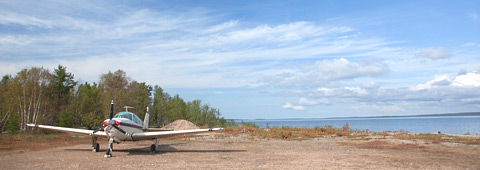
From the Citadel in Quebec City to Victoria’s Inner Harbour, from the humpback whales of Brier Island to Jasper National Park’s great fishing, Canada calls to us to come and visit. History buffs, adventurers, nature lovers, and cultural aficionados will be delighted with the variety of sights and experiences Canada offers. Its territories are huge, spanning 3.8 million square miles—making it the perfect flying trip—and the general-aviation-friendly country welcomes pilots from the “Lower 48” and Alaska. Flying across the border involves some preparation, so if you are planning to make the trip, these are the basic requirements.
Current passports are required for the pilot and all passengers (birth certificates have not been acceptable since January 2007, under the Department of Homeland Security and Western Hemisphere Travel Initiative), and the pilot must also have a current airman certificate with an English proficient endorsement, current medical certificate, and radio telephone operators permit. Any minor children on the flight accompanied by only one parent must have a notarized letter from the absent parent authorizing the trip.
 Your aircraft must have a standard airworthiness certificate, permanent registration certificate (no pink slips), and radio station license, as well as operating limitations and weight and balance information. If the aircraft is registered in a name other than your own, we recommend you bring a notarized letter allowing use of the aircraft. If internal fuel tanks have been added (to a passenger or baggage area), you’ll need Form 337 (FAA Major Repair and Alteration Form). In addition, aircraft must have an ID data plate, 12-inch registration marks if you're crossing the Alaska ADIZ, and a transponder with Mode C. Either a 121.5 MHz or a 406MHz ELT is acceptable for flight in Canada at this time. Survival equipment is required for flights in wilderness areas over land and flights over water.
Your aircraft must have a standard airworthiness certificate, permanent registration certificate (no pink slips), and radio station license, as well as operating limitations and weight and balance information. If the aircraft is registered in a name other than your own, we recommend you bring a notarized letter allowing use of the aircraft. If internal fuel tanks have been added (to a passenger or baggage area), you’ll need Form 337 (FAA Major Repair and Alteration Form). In addition, aircraft must have an ID data plate, 12-inch registration marks if you're crossing the Alaska ADIZ, and a transponder with Mode C. Either a 121.5 MHz or a 406MHz ELT is acceptable for flight in Canada at this time. Survival equipment is required for flights in wilderness areas over land and flights over water.
U.S. Customs and Border Protection (CBP) requires an annual user fee decal that must be purchased online in advance of your trip and affixed to the aircraft per the instructions that come with the decal. An Electronic Advance Passenger Information System (eAPIS) manifest must be filed with CBP at least one hour before departing from or arriving in the United States. Exception: If you overfly Canada without landing, no eAPIS manifest is required.
In addition, verify that your insurance covers your flight into Canada and bring proof of coverage. You’ll find more information about flying to Canada and many useful online resources for your trip on AOPA Online. And, of course, call AOPA with questions Monday through Friday, 8:30 a.m. to 6 p.m. Eastern time, 800/USA-AOPA (872-2672).



